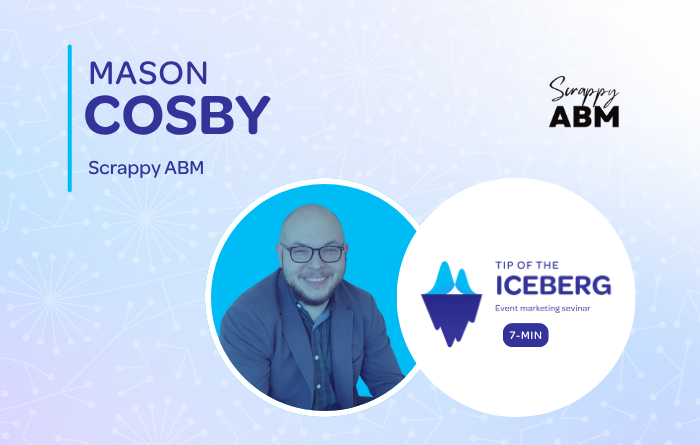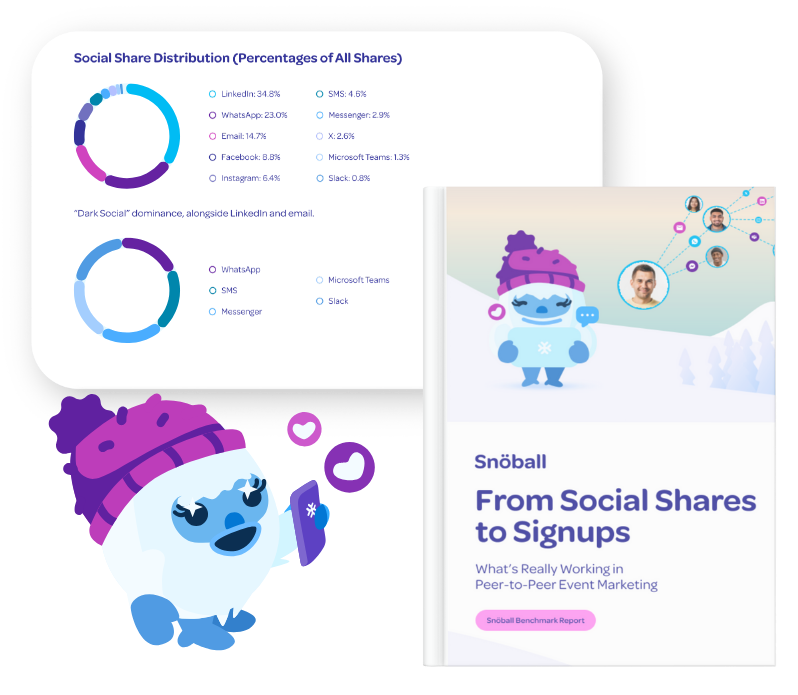If you’re investing time, energy, and budget into bringing speakers to your event, you want to make sure they’re not just showing up.
You want them actively engaging, drawing a crowd, and driving real value.
In Snöball’s latest Sevinar episode, Rachel Stephan sat down with Mason Cosby, founder and CEO of Scrappy ABM, who shares how he transformed speaking opportunities into real business results.
In fact, his approach led to a single speaking session turning into 30 booked meetings and 15 new clients.
Mason outlines seven tactics to maximize speaker participation at your events and get the same results as he did. Here’s a quick read:
1. Structure your approach with a smart framework
For a clear path to success, Mason recommends getting the structure right using a smart framework. His own playbook employs a simple yet effective 4D framework:
- Data: Help speakers identify who they’re targeting and why (the “targets” and “triggers”). For example, find those attendees interested in the topic but haven’t signed up yet.
- Distribution: Guide them on the best channels to reach attendees. This could be an event app or an online community.
- Destination: Clarify where they should direct interested participants
- Direction: Establish how they’ll measure success ( e.g. did more people register? Did attendance spike?)
Mason says: “Data is a mix of targets and triggers. So target being, who are we going after?
“And triggers would be – why are we reaching out?
“And when you have a good target and good triggers, that creates highly personalized, nuanced, and specific messaging.”
A clear framework helps speakers stop randomly networking and start making strategic connections.
2. Help speakers fill the room, not sell the room
Many speakers make the rookie mistake of trying to sell from the stage.
Mason suggests a more effective approach: get people to the session first.
“If I’m a speaker my primary goal and objective before my session is actually not to sell people or book meetings but to get people to the session. I have maybe 30 minutes. Let’s get them in the door.”
Encourage speakers to use pre-event communication to identify attendees who’d benefit from their session and try to invite them personally.
“I could segment by people that were interested in account-based marketing, but were not at my session. So that was the trigger.
“I knew they wanted to hear about account-based marketing. They weren’t coming to my thing so I figured let me do a one-to-one personalized outreach.”
3. Encourage action-oriented follow-up plans
Instead of hitting attendees with generic sales emails, empower your speakers to give attendees something tangible — like a quick template, worksheet, or a follow-up chat.
“What we did as speakers and as consultants is we actually met with people.
“We gave them a template from our session and just said, ‘Hey, like, go to your hotel room tonight and do these things.
“It’ll take you 30 minutes and then actually come back tomorrow, grab us, we’ll review it with you live.’
Such an approach plants the seeds for ongoing conversation rather than forcing immediate sales decisions.
4. Leverage LinkedIn for connection, emails to sell
The platform matters as much as the message.
Remind speakers that LinkedIn connections feel like networking while emails often read as sales pitches. As Mason points out:
“The only thing I’ll call out on LinkedIn versus email—LinkedIn is public. Email is private.
“If you shoot them an email, you’re selling. So the idea here is that you’re big on personal connections.”
The vibe on LinkedIn is more relaxed, making it easier to stay in touch without pressure.
It’s equally important to help speakers build relationships and not just sales pipelines.
5. Track what actually matters
Help your speakers look beyond basic attendance metrics.
Mason emphasizes the importance of measuring what truly drives business results:
“Direction is how we plan to track it… Tracking was, did we see an increase in registrants for the session or people that actually attended.”
He also suggests looking at long-term impact, not just immediate wins:
“Our primary goal and objective is audience size increases with people that are not actively engaged audiences in other places… we get them on our email list and then we follow up with them and then we see people convert nine to 10 months later.”
Guide your speakers to track meaningful metrics like:
- Increases in session attendance
- Number of meetings booked
- Leads added to their list
- Long-term conversions (even 9-10 months later)
6. Give them a place to send people
Speakers need more than a website.
They need a destination people want to return to – it could be a podcast, a newsletter or a content hub.
Mason emphasizes having a clear destination as part of his 4D framework:
“Destination is, what are we sending them to?”
He mentions how having a podcast gives him a perfect place to send people:
“I have my podcast you mentioned about the destination. You have somewhere to send them, which is still also valuable and educational.”
This approach provides much better results than traditional follow-up methods:
“If your entire strategy is, only that and there’s nowhere to send them and there’s nothing else to do other than you can meet us at an event where we’ll try to sell you or you can go to our website where we’re gonna try to sell you. That’s a hard road.”
Mason also found that inviting potential clients to be guests on his podcast—not to pitch, but to connect—creates remarkable opportunities:
“They’re actually our exact target account list and like I’m a nobody for some of these CMOs, and like they’ve never heard of me and they immediately said yes, within literally 30 minutes of giving the message.”
7. Always put value in what you say
If your speaker doesn’t have anything genuinely helpful to say, no tactic will save them. Mason says: “I’m gonna say this so bluntly, but like, if you don’t have something valuable that’s actually helpful for your buyers, like this doesn’t work.”
He stresses that his success mainly comes from consistently prioritizing education over sales:
“As I think about it, that’s the primary goal, which means from a data perspective, I need to figure out who’s not coming to my session but is at the event.”
Encourage your speakers to focus on solving real problems and not just promoting their brand.
When they provide templates, offer consultations, or share valuable insights, people naturally want to continue the relationship.
If they lead with real value, the results will follow.
Bottomline
Helping speakers get the most from your events doesn’t mean to just give them a stage and a mic.
You need to equip them with the right tools and tips to generate real business results.
As Mason Cosby shows, when speakers lead with value, focus on connection over conversion, and use a structured approach like the 4D framework, they can turn a 30-minute session into 30 meaningful conversations — and even 15 new clients.
Such an outcome happens when event organizers and speakers work together to make every touchpoint intentional.
Help them make this shift, and watch both their impact and your event’s reputation transform.
About Mason Cosby
Mason Cosby is the founder and CEO of Scrappy ABM, a company focused on building effective, low-budget account-based marketing (ABM) programs for B2B teams. With experience as a marketing leader at boutique firms, he’s sourced millions in revenue, boasting high ROI through practical strategies. Mason also hosts the Scrappy ABM podcast, sharing innovative, resource-light ABM tactics, and is a sought-after speaker on driving business results.
Find out how Snöball empowers your speakers to get more audience sign-ups for their event sessions 👇





